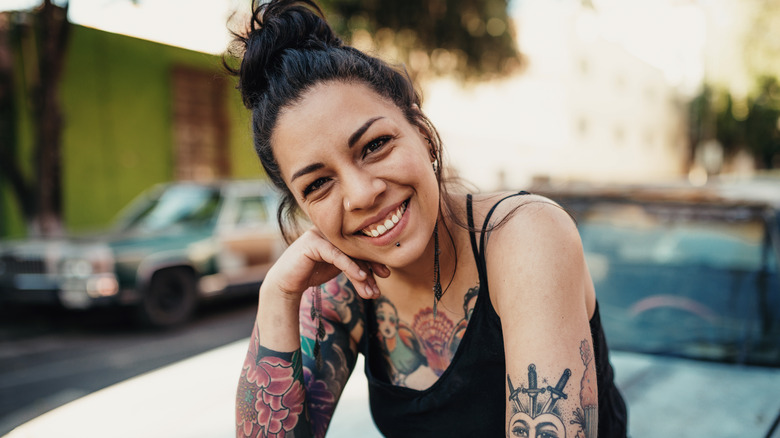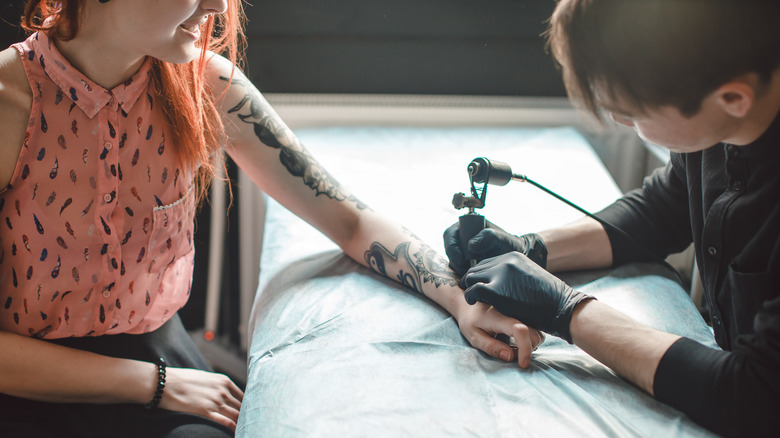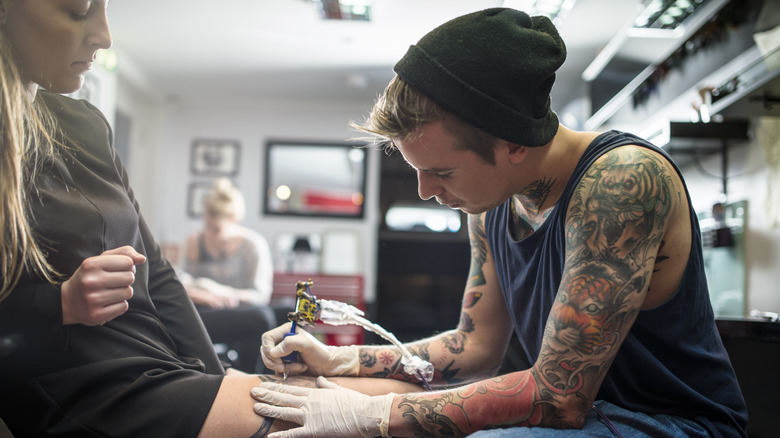What Are The Most Painful Tattoo Spots?
Anyone who's ever gotten a tattoo before will probably tell you that it hurt. But the level of pain will vary. Some will describe their experience as a tickle, others might say it felt like knives carving into their skin. But for the most part, people liken the sensation to having their skin scratched over and over. "I always tell my clients to imagine a cat continuously scratching them with hot claws. It's definitely a very acute, in-the-moment kind of pain," tattoo artist Anka Lavriv, who owns Black Iris Tattoo studio, explained to Allure. Of course though, exactly how much a tattoo session hurts will depend on a few different personal factors, such as a person's pain threshold and how big and intricate the ink they're getting is. Smaller, dainty tattoos, for example, will generally be less painful than something huge with a lot of detail. But one of the biggest factors that defines how painful a tattoo will be is actually where on your body it's going.
In general, the most painful places to get inked are locations that fall under one or more of these categories. If the area has thin skin, not much fat, is close to a bone, or has a high number of nerve endings, then it's probably going to hurt. A lot. But where exactly are those spots on the body, we hear you ask? Well, we'll tell you.
There are several places a tattoo is most likely to hurt
We're sorry to tell you that there are quite a few spots on the body getting a tattoo is likely to hurt more. First and foremost, it probably goes without saying that sensitive intimate areas are towards the top of the list. Tattooing places like the nipples and the breasts won't exactly feel like a tickle on the skin, while the groin is a particularly painful canvas because of all the nerve endings there. Similarly, the neck and the spine also contain a lot of nerve endings, as do certain areas on the face like the lips. Other spots to be a little more wary of? The hands and feet, as the skin there is thin and has plenty of nerve endings as well.
Equally, getting tattooed on any area where there's a crease is likely to induce some wincing. Most tattoo pain charts consistently place the armpits and the region behind the knees as the two of the most painful places to get inked, with the latter in particular being super painful because it contains several nerve endings connected to your knee joint.
Other painful tattoo locations include areas that are directly on top of or close to a bone. This includes the elbows and kneecaps, the rib cage (which can be made even more painful by the movement of breathing), the ankles, shins, and hips. These areas hurt because they have less body fat to diffuse the pain, and are therefor more susceptible to feeling vibration from the tattoo needle.
But there are ways to numb the pain of a tattoo
While there's no escaping discomfort when it comes getting ink, if you don't think you can handle a lot of pain, it's probably for the best to opt for an area that's lower on the pain scale. A few areas considered least painful include the thighs, calves, back, or the forearm. These spots tend to have thicker skin, more fat, and fewer nerve endings. However, keep in mind that everyone is different, and even areas considered less painful may still hurt a lot for some people.
But if you've got your heart set on getting inked on part of the body that's notoriously painful, there are a few tips to try to bring the pain levels down before your session. "Consider taking acetaminophen beforehand; while not a blood thinner, ibuprofen can increase the risk of a bruise. Discuss the use of a topical numbing cream with your tattoo artist prior to the treatment," Dr. Brendan Camp, a double board-certified dermatologist, suggested to Byrdie. There are also a few things to avoid having in your system. "Alcohol and certain supplements, such as vitamin E, garlic, ginger, gingko, ginseng can increase the risk of bleeding and bruising," Dr. Camp noted. Another great tip before getting a tattoo? A good night's sleep. Dr. Camp explained well-rested people are more likely to be prepared for pain. Equally, after the session, aftercare is super important to keep further pain to a minimum.


